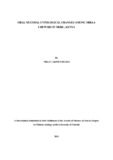| dc.contributor.author | Ogada, Nelly A | |
| dc.date.accessioned | 2013-11-13T08:21:39Z | |
| dc.date.available | 2013-11-13T08:21:39Z | |
| dc.date.issued | 2013 | |
| dc.identifier.citation | Masters of Science Degree in Clinical cytology | en |
| dc.identifier.uri | http://erepository.uonbi.ac.ke:8080/xmlui/handle/11295/58844 | |
| dc.description.abstract | Background: Miraa, qat, chat, cat, ghat or khat (Catha edulis), is a shrub indigenous to Eastern Africa and Arabic countries. It is cultivated in most Africa countries. Chewed miraa has sympathomimetic and euphoric effects and its chewing is a popular habit among some populations in Kenya. Habitual miraa chewing has been associated with oral lesions including oral cancer. It has also been associated with various toxic effects on the central nervous system, cardiovascular and reproductive system. In Kenya, no data exists among the population that chew miraa of oral mucosal changes associated with miraa chewing. Study Objective: To describe cytological changes of the oral mucosa among habitual miraa chewers in Meru Kenya. Setting: Recruitment was done in miraa selling and chewing kiosks in Meru town. Sample collection and specimen processing was done at Meru level V hospital and KNH/UON cytology laboratory respectively. Subjects: Two hundred and nineteen (219) consenting participants aged 18 years and above with a history of chewing miraa for more than three years were recruited. Design and method: This is a cross-sectional study. A total of 219 consenting adults who met the inclusion criteria were recruited. Snowball sampling technique was also used to hasten enrolment. Buccal smears were collected using cytobrush and examined to determine oral mucosal cytological changes while face to face interviews was used to collect social demographic data as well as risk factors for oral mucosal disease. Data management and statistical analysis: Frequency and percentages were used to describe the patterns of oral mucosal cytology including the occurrence of neoplastic lesions. All statistical analyses were performed using STATA version 12.
Results: Most of the participants were male with an average age of 28.73 years. Majority, 99.5% were negative for oral mucosal neoplasia and 0.5% had atypical squamous cells of undetermined significance. A few of the participants (2.3%) had bacterial infection and non-specific inflammation - probably more due to poor oral hygiene than miraa chewing. Age, quantity of miraa chewed and the length of time the bolus stay in the mouth were not associated with oral lesions. The average duration that this study group had chewed miraa was 5 years and this does not seem to have been significantly associated with oral lesions. The other risk factors including cigarette smoking, use of illicit drugs and alcohol use were not associated with oral lesions. Conclusion: Inflammatory lesions were the most common cytologic finding in miraa chewers in this population. Oral mucosal neoplasia is not common in short term (5years) miraa chewers in Meru. Analysis of association of risks factors with neoplastic lesions in miraa chewers was performed and found not to be significant. Recommendation:
1. Oral mucosal neoplasia is not common in persons with an average miraa chewing period of five or less years in this fairly young population in Meru.
2. Inflammatory lesions were the most common positive findings and this could be attributed to poor oral hygiene and partly due to physical damage to the oral mucosa from habitual miraa chewing.
3. Almost half of the participants were exposed to alcohol and smoking which are known long term risk factors for oral neoplasia. | en |
| dc.language.iso | en | en |
| dc.publisher | University of Nairobi | en |
| dc.title | Oral mucosal cytological changes among miraa chewers in Meru, Kenya | en |
| dc.type | Thesis | en |
| dc.description.department | a
Department of Psychiatry, University of Nairobi, ; bDepartment of Mental Health, School of Medicine,
Moi University, Eldoret, Kenya | |
| local.publisher | Department of Human Pathology | en |

